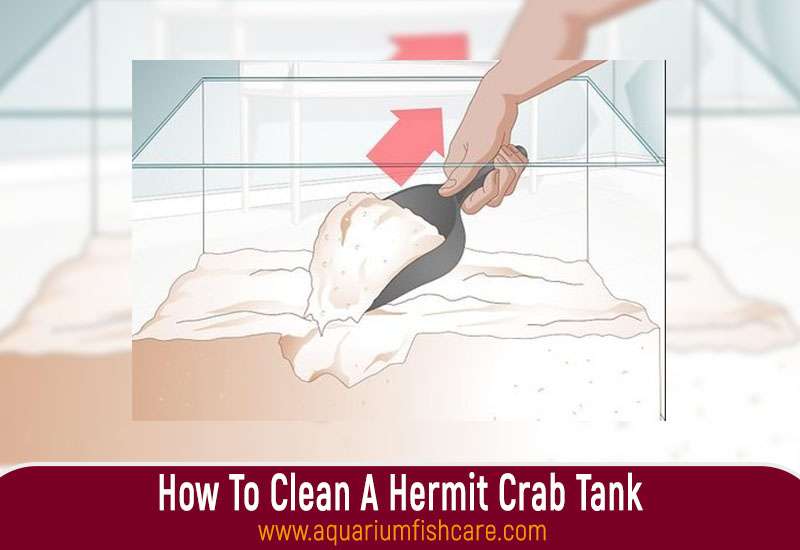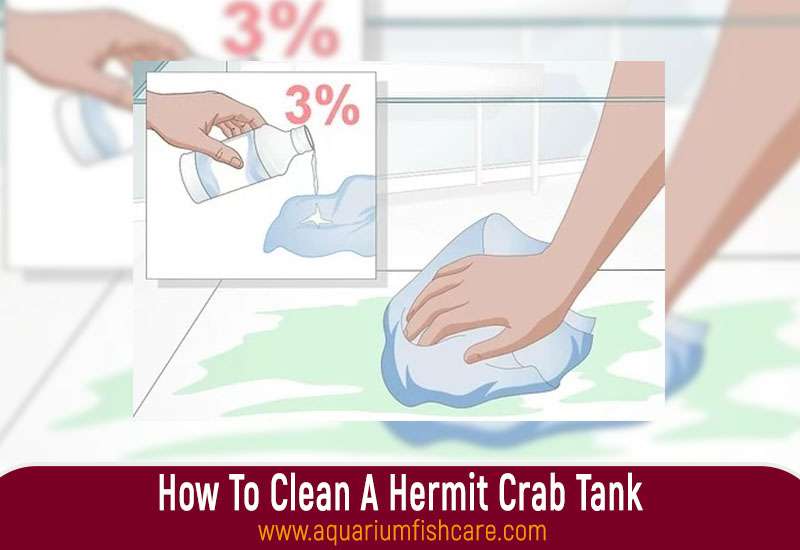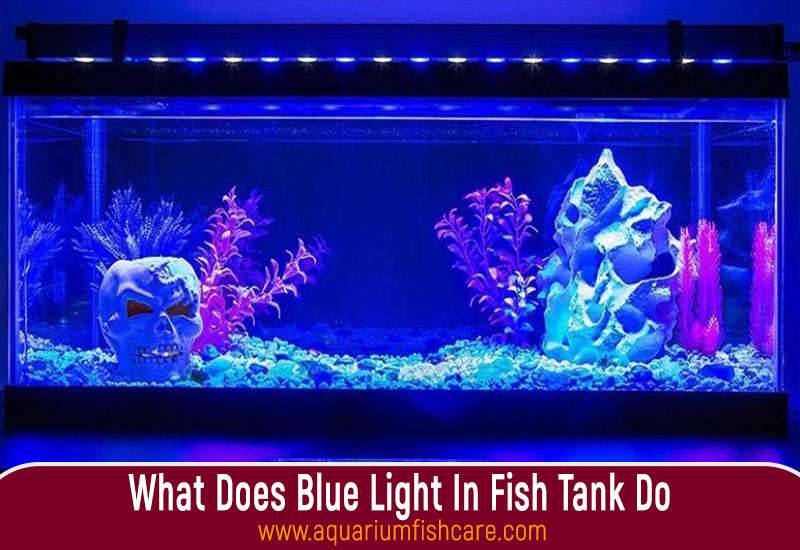How To Clean A Hermit Crab Tank: To clean a hermit crab tank, first remove the crabs, then clean using vinegar and water solution. Dry completely before adding sand and shells.
Keeping a hermit crab tank clean is essential for the health and well-being of your pets. Regular maintenance and cleaning not only ensure a pleasant environment for the crabs but also prevent any potential health issues. In this guide, we will discuss the step-by-step process of cleaning a hermit crab tank, including the necessary supplies and precautions to take.
With proper cleaning techniques, you can maintain a clean and healthy environment for your hermit crabs, promoting their overall well-being and longevity.

Importance Of Regular Cleaning
Regular cleaning of a hermit crab tank is crucial to the health and well-being of your pet. It helps maintain a clean and hygienic environment, preventing the buildup of harmful bacteria and parasites. Moreover, a clean tank provides a comfortable and stress-free habitat for your hermit crabs, promoting their overall health and longevity.
Frequency Of Cleaning
It is recommended to clean a hermit crab tank at least twice a year to ensure a healthy living environment for your pets. However, the cleaning frequency can vary based on the activity and behavior of your hermit crabs. If your crabs are molting or not all of them are on the surface, it’s best to wait until they are all active before initiating the cleaning process.
Safe Cleaning Products
When cleaning a hermit crab tank, it’s essential to use safe and non-toxic cleaning products. A vinegar and water solution can be used to clean the tank effectively without harming your hermit crabs. Ensure the tank is thoroughly dried before adding back the sand, shells, and your pets to maintain their well-being.
Basic Tank Maintenance
To maintain a clean hermit crab tank, start by removing crabs and using a vinegar-water solution to clean them before adding fresh sand and shells. Replace the substrate three times a year, and scoop out debris weekly for a healthier habitat.
Removing Hermit Crabs
Begin by carefully removing hermit crabs from the tank and placing them in a temporary container.
- Handle hermit crabs gently to avoid stress.
- Ensure the temporary container has enough space and ventilation.
Cleaning Glass And Substrate
Next, focus on cleaning the glass walls and substrate of the tank.
- Use a mixture of vinegar and water to clean the tank walls thoroughly.
- Rinse the tank with clean water and dry it before adding a new substrate.
- When cleaning the substrate, remove any waste or debris to maintain a clean environment.
Deep Cleaning Process
When it comes to keeping your hermit crab tank clean and healthy, a deep cleaning process is essential. This involves thoroughly replacing the substrate and sanitizing the tank to create a safe and comfortable environment for your hermit crabs. By following these steps, you can ensure that your hermit crab tank is clean and well-maintained.

Thorough Substrate Replacement
To start the deep cleaning process, begin by thoroughly replacing the substrate in your hermit crab tank. This involves removing all of the existing substrate and replacing it with fresh, clean sand or coconut fiber. It is important to choose a substrate that is suitable for hermit crabs and will provide them with a comfortable and natural habitat.
Here are a few steps to follow when replacing the substrate:
- Remove all hermit crabs from the tank and place them in a temporary container.
- Carefully scoop out the old substrate using a small shovel or scoop.
- Dispose of the old substrate in a trash bag or compost bin.
- Thoroughly rinse the tank with water to remove any debris or residue.
- Add the fresh substrate to the tank, ensuring that it is evenly distributed and provides a sufficient depth for the hermit crabs to burrow.
- Smooth the surface of the substrate to create a level and comfortable environment for the hermit crabs.
Sanitizing The Tank
In addition to replacing the substrate, sanitizing the tank is an important step in the deep cleaning process. This helps to eliminate any bacteria or parasites that may be present in the tank, reducing the risk of infections and diseases for your hermit crabs.
Here are some tips for sanitizing the tank:
- Prepare a mixture of vinegar and water in a spray bottle.
- Spray the solution generously on the inner walls of the tank.
- Use a sponge or cloth to scrub the tank, paying extra attention to areas that may have accumulated dirt or algae.
- Rinse the tank thoroughly with clean water to remove any residue.
- Allow the tank to air dry completely before reintroducing the hermit crabs.
By following these steps and incorporating deep cleaning into your regular maintenance routine, you can ensure that your hermit crab tank remains clean and hygienic for your beloved pets.
Adding Tank Enhancements
To clean a hermit crab tank, remove the crabs and use a vinegar and water solution to clean the tank. Once dry, add fresh sand, shells, and the hermit crabs back in. Remember to scoop out any debris from the substrate regularly for a clean and healthy environment.
Once you have thoroughly cleaned and sanitized your hermit crab tank, it’s time to focus on adding some enhancements that will make the environment more engaging and comfortable for your little companions. Here are some important aspects to consider:
Decor And Landscaping
The right decor and landscaping can make a huge difference in your hermit crab’s tank. It not only provides visual appeal but also offers opportunities for your crabs to explore and exercise. Consider using a combination of natural elements, such as driftwood, rocks, and live plants, along with artificial decorations like caves or tunnels. Make sure to arrange them in a way that creates hiding spots and climbing areas for your hermit crabs.
Ensuring Proper Heat And Humidity
Hermit crabs require specific temperature and humidity levels to thrive. To maintain these conditions, it’s essential to have the right equipment in place. Use a thermostat-controlled ceramic heater or heat pad to provide an optimal temperature range, typically around 75-85°F. Additionally, you will need a humidity gauge and a mister to ensure that the humidity stays within the recommended range of 70-80%. Mist the tank regularly to maintain the necessary moisture levels.
Creating A Comfortable Substrate
The substrate in a hermit crab tank serves as a substrate for burrowing, moisture retention, and providing a soft surface for molting. A mixture of sand and coconut fiber works well as it mimics the natural environment of hermit crabs. Make sure the substrate is at least 3-4 inches deep to allow for digging. Additionally, it’s crucial to keep the substrate moist but not too wet.
Providing Proper Lighting
Hermit crabs require a day-night cycle to maintain their natural rhythm. A full-spectrum UVB bulb can simulate natural sunlight and provide essential vitamins for their overall health. Ensure the lighting is set on a timer to provide 12-14 hours of light and 10-12 hours of darkness daily.
Supplementing With Nutritious Food And Water
In addition to a varied diet of fresh fruits, vegetables, and protein, hermit crabs need access to freshwater and saltwater bowls. The freshwater should be dechlorinated and changed daily, while the saltwater should be prepared with a marine salt mix specifically designed for hermit crabs. These bowls should be placed on opposite ends of the tank to allow easy access for your crabs.
By incorporating these tank enhancements, your hermit crab will have a fun and comfortable home that promotes their well-being and happiness.
Expert Tips And Insights
When it comes to maintaining a clean and healthy environment for your hermit crabs, it’s important to follow expert tips and insights for effective care. Here are some professional recommendations and considerations to keep in mind when cleaning a hermit crab tank.
Professional Recommendations
When it comes to cleaning a hermit crab tank, it’s essential to follow professional recommendations to ensure the well-being of your pets. Here are some expert tips to guide you through the process:
- Remove the hermit crabs from the tank before beginning the cleaning process to ensure their safety.
- Clean the tank with vinegar and water solution, ensuring it is thoroughly dried before re-introducing the substrate, shells, and hermit crabs.
- Regularly inspect and clean the tank accessories such as shells, plants, and decorations to maintain a hygienic habitat for the crabs.
Molting Considerations
During the cleaning process, it’s important to consider the molting behavior of hermit crabs. Here’s what you should keep in mind:
- Hermit crabs molt periodically, and their molting cycle may interfere with the cleaning schedule. If the crabs are molting, it’s best to postpone the cleaning process until they have completed this natural process.
- When one or more hermit crabs are undergoing molting, it’s advisable to wait until they have resurfaced before initiating the cleaning activities to avoid any disruption or stress to the molting crabs.
Optimizing Health And Safety
Keeping a hermit crab tank clean is essential for optimizing the health and safety of your beloved crustaceans. A clean environment can help prevent contamination and promote healthy behavior in your pets. By following proper cleaning practices and monitoring their behavior, you can ensure that your hermit crabs thrive in a safe and hygienic habitat.
Preventing Contamination
Preventing contamination is crucial for maintaining a healthy hermit crab tank. Regularly check for any signs of mold, mildew, or foul odors, which may indicate contamination. Clean and disinfect the tank using a mild vinegar and water solution, ensuring it is completely dry before reintroducing the substrate, shells, and hermit crabs. Proper cleaning and disinfection will help prevent the spread of harmful bacteria and maintain a safe environment for your pets.
Monitoring Hermit Crab Behavior
Monitoring hermit crab behavior is key to ensuring their health and safety. Keep a close eye on their activity levels, feeding habits, and interactions with the tank environment. Any unusual behavior, such as lethargy, refusal to eat, or excessive hiding, could indicate an issue with the tank’s cleanliness or the overall habitat. By observing their behavior, you can identify potential problems early and take necessary action to address them.
Frequently Asked Questions Of How To Clean A Hermit Crab Tank
How Often Should You Clean A Hermit Crab Tank?
Clean your hermit crab tank about twice a year. If your crabs are molting, wait until they’re on the surface again before cleaning. Use a vinegar and water solution or biodegradable cleaners to clean the tank. Avoid using bleach, as hermit crabs are sensitive to chemicals.
How Do I Clean My Hermit Crab Cage?
To clean a hermit crab cage, remove crabs, use a vinegar/water solution, dry, and add sand, shells, and crabs back. Avoid harsh chemicals.
How Often Should You Change The Sand In A Hermit Crab Tank?
Change the sand in a hermit crab tank completely about three times a year. Scoop out waste twice a week for maintenance.
What Cleaner Is Safe For Hermit Crabs?
To clean a hermit crab tank, use a vinegar solution or biodegradable cleaners as hermit crabs are sensitive to chemicals. In many cases, plain hot water may be sufficient. Avoid using bleach. When cleaning, remove the hermit crabs, and clean, and dry the tank before adding sand, extra shells, and the hermit crabs.
How Often Should You Clean A Hermit Crab Tank?
Cleaning should be done about twice a year unless your crabs are molting. Wait until they’re all on the surface before cleaning.
How Do I Clean My Hermit Crab Cage?
Remove the crabs and clean the tank with a vinegar and water solution. Dry it before adding sand, shells, and crabs.
How Often Should You Change The Sand In A Hermit Crab Tank?
Replace the sand completely about three times a year. Scoop out waste and debris twice a week.
Conclusion
Regular cleaning of your hermit crab tank is crucial for their well-being and health. Remember to clean the substrate, water dishes, decorations, and shells regularly. Maintain a consistent cleaning schedule to provide a comfortable environment for your hermit crabs. Happy cleaning!


